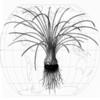| Publication Type: | Journal Article |
| Year of Publication: | 1982 |
| Authors: | U. Kristen, Liebezeit, G., Biedermann, M. |
| Journal: | Annals of Botany |
| Volume: | 49 |
| Issue: | 5 |
| Pagination: | 569 - 584 |
| Date Published: | 1982/// |
| Keywords: | Endoplasmic reticulum, Isoetes lacustris, Ligule, Polysaccharide secretion, Protein secretion, Ultrastructure |
| Abstract: | Mature ligules of Isoetes lacustris can be divided anatomically into three ultrastructurally different regions. First, the basal region contains large numbers of two types of protein bodies. Second, the cells of the sub-marginal region are characterized by a well developed Golgi apparatus closely associated with the tubular compartments of the endoplasmic reticulum. Third, the peripheral region consists of one to three layers of cells showing an extremely well developed rough asternal and smooth tubular endoplasmic reticulum (ER). The tubular ER compartments are frequently observed in close attachment to the plasmalemma. The outermost peripheral cells are covered with a mucilaginous layer. The dry matter in the mucilage consists of 49 per cent polysaccharides and 22 per cent proteins. The polysaccharide fraction, analysed by ion exchange chromato-graphy, consists mainly of glucose, arabinose, galactose and uronic acids. The protein fraction was analysed by SDS gel dectrophoresis and by high performance liquid-chromatographic separation of the amino acids. The analysis shows a protein pattern very similar to that of the peripheral ligule tissue. It is suggested, therefore, that the material of the external mucilage is secreted by the peripheral ligule cells. The secretional mechanism appears to be a direct release of polysaccharides and proteins by the tubular components of the ER. There is no indication of secretion via the Golgi apparatus. Because of its high activity in protein synthesis and secretion, it is suggested that the ligule is a vestigial structure, which, in extinct genera, might have functioned as a digestive organ. © 1982 Annals of Botany Company. |
| URL: | http://www.scopus.com/inward/record.url?eid=2-s2.0-0008468496&partnerID=40&md5=1f528bd1dc2bfcc71d9f4a8b7f66d660 |
The ligule of isoetes lacustris: Ultrastructure, mucilage composition, and a possible pathway of secretion
Taxonomic name:
